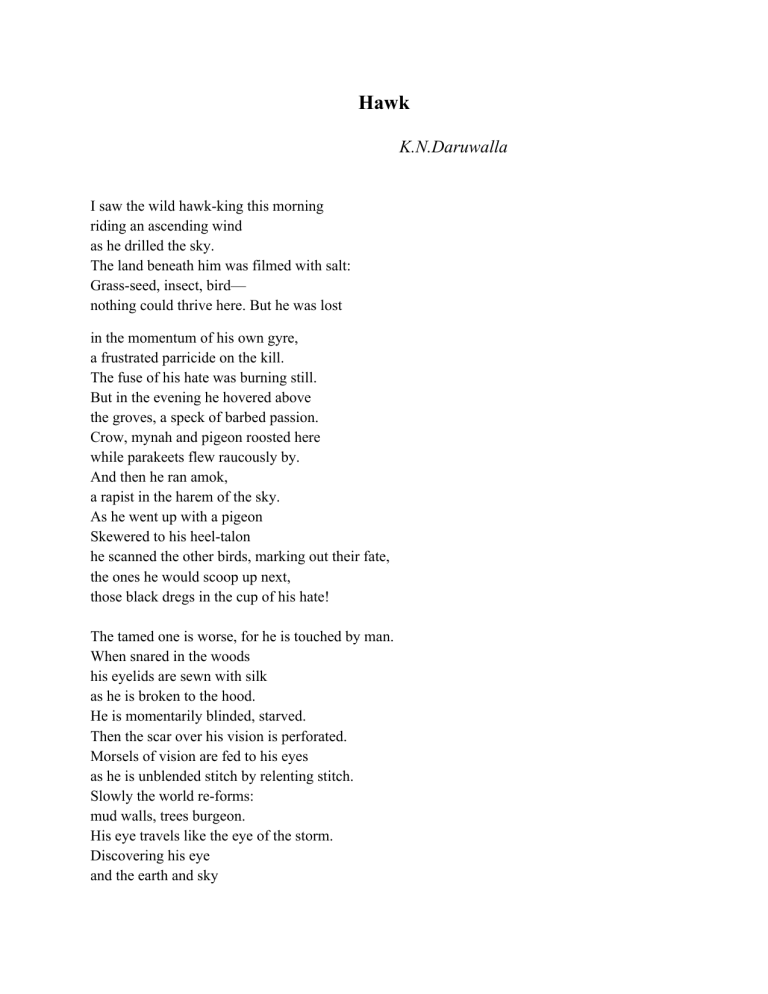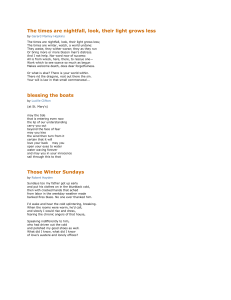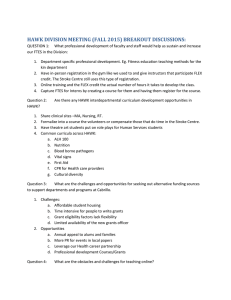
Hawk K.N.Daruwalla I saw the wild hawk-king this morning riding an ascending wind as he drilled the sky. The land beneath him was filmed with salt: Grass-seed, insect, bird— nothing could thrive here. But he was lost in the momentum of his own gyre, a frustrated parricide on the kill. The fuse of his hate was burning still. But in the evening he hovered above the groves, a speck of barbed passion. Crow, mynah and pigeon roosted here while parakeets flew raucously by. And then he ran amok, a rapist in the harem of the sky. As he went up with a pigeon Skewered to his heel-talon he scanned the other birds, marking out their fate, the ones he would scoop up next, those black dregs in the cup of his hate! The tamed one is worse, for he is touched by man. When snared in the woods his eyelids are sewn with silk as he is broken to the hood. He is momentarily blinded, starved. Then the scar over his vision is perforated. Morsels of vision are fed to his eyes as he is unblended stitch by relenting stitch. Slowly the world re-forms: mud walls, trees burgeon. His eye travels like the eye of the storm. Discovering his eye and the earth and sky with it, he leaps from earth to ether. Now the sky is his eyrie. He ferocious floats on splayed wings; then plummets like a flare, smoking, and then a gust of feathers proclaims that has struck. The tamed one is worse, for he is touched by man. Hawking is turned to a ritual, the predator’s passion honed to an art; as they feed the hawk by carving the breast of the quarry bird and gouging out his heart. They have flushed him out of the tall grasses, the hare, hunted now in pairs by mother hawk and son. They can’t kill him in one fell swoop. But each time the talons cart away a patch of ripped fur. He diminishes, one talon-morsel at a time. He is stunned by the squall of wings above. His heart is a burning stable packed with whinnying horses. His blood writes stories on the scuffed grass! His movements are a scribble on the page of death. I wouldn’t know when I was stolen from the eyrie I can’t remember when I was ensnared. I only know the leather disc which blots out the world and the eyelids which burn with thwarted vision. Then the perforations, and yet the blue iris of heaven does not come through. I can think of a patch of blue sky when shown a blue slide. But I am learning how to spot the ones crying for the right to dream, the right to flesh, the right to sleep with their own wives— I have placed them. I am sniffing The air currents, deciding when to pounce. I will hover like a black prophecy weaving its moth-soft cocoon of death. I shall drive down with the compulsive thrust of gravity, trained for havoc, my eyes focused on them like the sights of a gun. During the big drought that is surely going to come the doves will look up for clouds, and it will rain hawks. Keki Nasserwanji Daruwalla (1937-) Keki Nasserwanji Daruwalla was born in Lahore in January 24, 1937. His father, N.C. Daruwalla was professor in Government College Lahore. Keki completed his masters in English Literature from Punjab University. While pursuing his craft of writing, he kept on serving the Indian police Service industriously. His first book of poetry was “Under Orion”, which was published in 1970 and his “Apparition in April” published in 1971 for which he was given the Uttar Pradesh State Award in 1972. Subsequently, his third book of poetry “Crossing of Rivers” was published by the Oxford University Press in 1976. His poems appeared in many poetry anthologies. Even, he has himself edited an anthology of modern Indian poetry under the title “Two Decades of Indian Poetry” in English — 1960 – 1980. He was awarded Sahitya Akademi Award in 1984., Many other eloquent books of poetry are such as “The Keeper of the Dead” “A Summer of Tigers”, “ The Map-maker” etc. In October, 2015, Keki Daruwalla returned the Sahitya Akademy Award. Basically, it was a token of protest against physical violence against authors. He also contended that Sahitya Akademi as an organization remained silent over the issue of violence. Hawk: A Summary Hawk’ has been taken from The Keeper of the Dead published in 1982. The poem explains how hawk is trained as a hunting bird. It is describing human behaviour. Throughout the poem the poet has used ‘he’ for the hawk giving it a kind of human identity. This bird of prey projects an image of violence that is a common pattern of behaviour in human society. The hawk portrayed as a symbol of the destructive instinct in man. The opening section catches the hawk at an intense moment of killing. The wild hawk, a powerful bird of prey, is seen hunting other birds in the morning. It has speed. When it flies up in the sky it seems to drill a hole into it. To him the land seems covered with a thin film of salt. If there is too much salt in the soil, no vegetation will grow there. Similarly, when the hawk is prowling about in the sky, no ‘grass-seed, insect, bird’ can thrive. This hawk is driven by hatred which is like the burning fuse of a bomb ready to go off. In the evening too, the hawk hovers above ‘the groves’ looking for prey. From the ground he looks like a speck but he is a speck of ‘barbed passion’, always ready to kill. Birds like crows, mynahs or pigeons are roosting below. When a parakeet becomes aware of the hawk’s presence it flies away ‘raucously’. By hinting at the silence of the roosting birds and describing the noise made by a flying parakeet, the poet creates a sense of lurking danger in the form of the hawk. At any moment, the hawk may swoop down on the birds. He has been compared to a rapist in the harem of the sky. He picks up birds at will. As he holds a pigeon in his talons, he scans the other birds and tries to decide which bird he will pick up next. The wild, predatory hawk is burning with hatred which is like a cup in which the smaller birds are the ‘dregs’ that he scoops up. The second section describes how a hawk is tamed. Such a hawk is much more destructive because he has been ‘touched by the hand of man’. The poem then describes how a hawk is trained to hunt. The training is a painful and frustrating experience for the hawk. His eyes are covered: ‘his eyelids are sewn with silk’. The word ‘sewn’ suggests the pain that the young hawk has to go through. You must have come across the expression ‘eagle-eyed’. The hawk’s most precious possession is his remarkable eyesight but that is taken away from him temporarily so that he can be trained. The next few lines describe how the hawk is given back his sense of sight bit by bit. The poet uses the metaphor of food when he says that ‘morsels of vision are fed to his eyes’. When the hawk can see again, he is fully trained to kill at the command of his master. The hawk’s destructiveness is suggested when his eye is described as ‘the eye of the storm’. The hawk then begins to hunt. He is described as leaping up into the sky, hovering on ‘splayed wings’ and then suddenly plummeting ‘like a flair’ and striking the quarry in a ‘gust of feathers’. The word ‘storm’ with which the previous movement ended appears to anticipate ‘gust’ in this movement. Man has made hawking a fine art and a ritual. The section ends with the image of a hawk being fed morsels of meat from the body of the bird he has killed. The third section describes how a pair of trained hawks, ‘the mother hawk and son’, hunts a hare. They attack it repeatedly, and its death is slow. This section also suggests how the hunted hare feels. Its heart is pounding with fear; it is like a stable full of whinnying horses. The last two lines describe pictorially how the hare’s blood can be seen scattered on the grass where it was killed. The final section the hawk himself is telling his story. He begins by saying that he has no memory of the time when he was ‘stolen from the eyrie’. The only thing he remembers is the leather disc that was put on his eyes. He mentions the painful stitching of his eyelids. But now the hawk is trained. He is learning how to spot the birds he has to kill. Like the young hawk when he was captured, these birds too have a right to live and to procreate. But the hawk has been trained to take that right away. In the closing lines of the poem, the hawk tells us how he feels when he hunts other birds. His presence in the sky means certain death of a bird. There are a number of expressions here that suggest it. You immediately think of ‘black prophecy’,‘moth-soft cocoon of death’ and eyes focussed like ‘the sights of a gun.’In the concluding two lines the point of view changes from that of a hawk to a dove’s. There will be a drought and instead of rain the doves will find hawks raining down on them.

